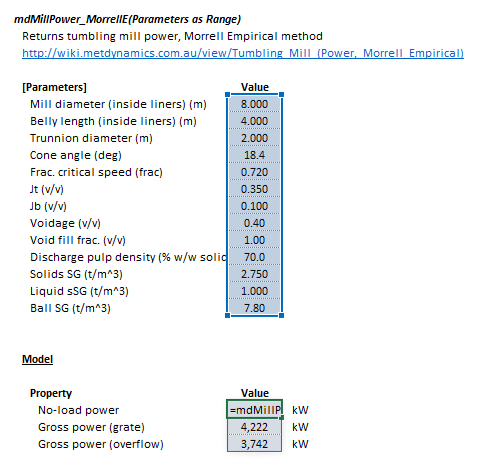Description
This article describes the Morrell Empirical (Morrell E) method for estimating the power draw of a tumbling mill.[1]
The Morrell E model is a set of empirical equations based on the performance of the theoretical Morrell Continuum model. The model was originally intended to be simpler, and therefore easier to use in practice, than the theoretical Morrell C method.
Model theory
 This content is available to registered users. Please log in to view. This content is available to registered users. Please log in to view.
|
Excel
The Morrell Empirical mill power model may be invoked from the Excel formula bar with the following function call:
=mdMillPower_MorrellE(Parameters as Range)
Invoking the function with no arguments will print Help text associated with the model, including a link to this page.
The Parameters array and model results are defined below in matrix notation, along with an example image showing the selection of the same arrays in the Excel interface:
SysCAD
The Morrell Empirical power model is an optional calculation for tumbling mill units. If selected, the input and display parameters below are shown.
| Tag (Long/Short)
|
Input / Display
|
Description/Calculated Variables/Options
|
| MorrellE
|
| HelpLink
|

|
Opens a link to this page using the system default web browser. Note: Internet access is required.
|
| MillDiameter
|
Input/Display
|
Diameter of the mill (inside liners).
|
| BellyLength
|
Input/Display
|
Length of the cylindrical section (belly) of the mill (inside liners).
|
| TrunnionDiameter
|
Input/Display
|
Diameter of the trunnion (inside liners).
|
| FracCS
|
Input/Display
|
Fraction critical speed of the mill.
|
| Jt
|
Input/Display
|
Volumetric fraction of the mill occupied by balls and coarse rock (including voids).
|
| Jb
|
Input/Display
|
Volumetric fraction of the mill occupied by balls (including voids).
|
| Voidage
|
Input/Display
|
Volumetric fraction of interstitial void space in the charge. Usually 0.4.
|
| VoidFillFraction
|
Input/Display
|
Volumetric fraction of interstitial grinding media voidage occupied by slurry.
|
| ConeAngle
|
Input/Display
|
Angular displacement of the cone surface from the vertical direction.
|
| DischargePulpDensity
|
Display
|
Mass fraction of solids in discharge slurry.
|
| SolidsSG
|
Display
|
Specific Gravity or density of solids.
|
| LiquidsSG
|
Display
|
Specific Gravity or density of liquids.
|
| BallSG
|
Input/Display
|
Specific Gravity or density of balls.
|
| NoLoadPower
|
Display
|
Power input to the motor when the mill is empty (no balls, rocks or slurry).
|
| NetPower.Grate
|
Display
|
Charge motion power, including losses, for a grate discharge mill.
|
| NetPower.Overflow
|
Display
|
Charge motion power, including losses, for an overflow discharge mill.
|
| GrossPower.Grate
|
Display
|
Gross power input to the motor, grate discharge mill.
|
| GrossPower.Overflow
|
Display
|
Gross power input to the motor, overflow discharge mill.
|
See also
References
- ↑ Morrell, S., 1996. Power draw of wet tumbling mills and its relationship to charge dynamics. Pt. 2: an empirical approach to modelling of mill power draw. Transactions of the Institution of Mining and Metallurgy. Section C. Mineral Processing and Extractive Metallurgy, 105.






